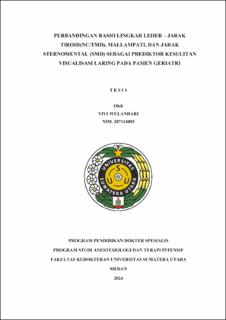Perbandingan Rasio Lingkar Leher – Jarak Tiroid (NC/TMD), Mallampati, dan Jarak Sternomental (SMD) sebagai Prediktor Kesulitan Visualisasi Laring pada Pasien Geriatri
Comparison of the Ratio of Neck Circumference-Thyroid Distance (NC/TMD) with Mallampati and Sternomental Distance (SMD) as Predictors of Larynx Visualization Difficulties in Geriatric Patients

Date
2024Author
Wulandari, Vivi
Advisor(s)
Lubis, Andriamuri Primaputra
Winata, Ade
Metadata
Show full item recordAbstract
Introduction: The intubation procedure is one of the most commonly performed medical interventions in clinical practice. However, approximately 12.7% of these procedures are deemed unsuccessful on the first attempt, which is also associated with the occurrence of side effects such as aspiration trauma, soft tissue damage, and even cardiac arrest. Laryngeal visualization is considered crucial in the intubation procedure as it is directly related to the operator’s performance. This study aims to evaluate several potential predictors of the degree of difficulty in laryngeal visualization during intubation.
Methods: This observational analytic study with a cross-sectional design was conducted at Adam Malik Hospital and Haji Hospital, Medan, Indonesia, from August to September 2024. Researchers included patients over 60 years of age who underwent elective intubation procedures with an ASA score of 1-3. Before the intubation was performed, the researchers measured the neck circumference-to-thyroid distance ratio (NC/TMD), the Mallampati score, and the sternomental distance (SMD) to be associated with the degree of difficulty in laryngeal visualization using the Cormack-Lehane scale. Statistical analysis in this study was performed using SPSS version 24.0.
Results: The researchers included 55 patients with a mean age of 65.17 ± 3.86 years, of whom 58.2% were female. All dependent variables evaluated in this study showed significant differences (P<0.05) between the difficult and easy laryngeal visualization groups. An NC/TMD ratio >5 was considered predictive of difficult laryngeal visualization, as were a Mallampati score of 3/4 and an SMD ≤13.5 cm. Furthermore, the variable with the best diagnostic accuracy in this study was the SMD, with sensitivity, specificity, PPV, and NPV of 93.55%, 95.83%, 96.67%, and 92.00%, respectively.
Conclusion: SMD is the best predictor of difficult laryngeal visualization in geriatric patients, with the diagnostic ability of NC/TMD and the Mallampati score also statistically significant.
Collections
- Master Theses [178]
